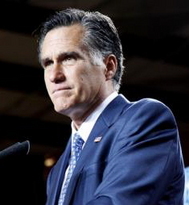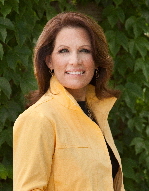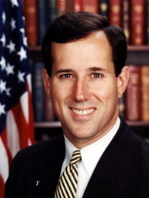Staging the GOP Debates: Where You Stand Depends on Where You Sit (In the Polls)
The most common neighbors on the Republican debate stage have been Perry/Romney, Perry/Paul, and Gingrich/Santorum

Some of these candidate ‘pairings’ have produced debate magic – such as Mitt Romney laying his hands on Rick Perry during a heated exchange over illegal immigration in Nevada, and Perry and Ron Paul gesturing numerical signs to tabulate the number of departments each would cut as president on Wednesday evening in Michigan.
Of course, the debate’s media sponsors take great care to strategically place particular candidates next to others.
And what patterns have emerged thus far?
Smart Politics analyzed the candidate staging of the six Republican presidential debates that have been conducted since Rick Perry joined the field and observes that candidate positioning on the stage is directly related to who is leading or surging in the national polls and who is falling off the map.
For starters, Mitt Romney, who has been polling in first or second in national surveys throughout the entirety of this three-month stretch, has drawn one of the center positions in five of the six debates.
Center slots (counted left-to-right from the audience perspective) are #4 and #5 in an eight-candidate forum (California, Florida’s first debate, New Hampshire’s second debate, and Michigan), #4 in a seven-candidate forum (Nevada), and #5 in a nine-candidate forum (Florida’s second debate).
Romney appeared in the #4 slot in California, the first Florida debate, Nevada, and Michigan and in the #5 slot in New Hampshire.
As depicted in the table below, the only time Romney has yielded a center slot was in the second debate in Florida sponsored by Fox News and Google.
In that nine-candidate debate, Rick Perry held the fifth and center slot, with Romney in the neighboring sixth slot. At the time of that debate, Perry was still running first in the national polls, explaining his center-slot position.
Staging of Candidates at Republican Presidential Debates, September 2011-Present
|
Debate
|
#1
|
#2
|
#3
|
#4
|
#5
|
#6
|
#7
|
#8
|
#9
|
|
CA
|
Sant.
|
Ging.
|
Bach.
|
Romney
|
Perry
|
Paul
|
Cain
|
Hunt.
|
|
|
FL 1
|
Hunt.
|
Cain
|
Bach.
|
Romney
|
Perry
|
Paul
|
Ging.
|
Sant.
|
|
|
FL 2
|
Johnson
|
Sant.
|
Ging.
|
Paul
|
Perry
|
Romney
|
Bach.
|
Cain
|
Hunt.
|
|
NH 2
|
Hunt.
|
Bach.
|
Perry
|
Cain
|
Romney
|
Paul
|
Ging.
|
Sant.
|
|
|
NV
|
Sant.
|
Paul
|
Cain
|
Romney
|
Perry
|
Ging.
|
Bach.
|
|
|
|
MI
|
Sant.
|
Bach.
|
Ging.
|
Romney
|
Cain
|
Perry
|
Paul
|
Hunt.
|
|
Slots are numbered left to right from the audiences perspective. Table compiled by Smart Politics.
The second center slot in an even-numbered candidate forum has always been held by Romney’s chief rival at the time of the debate.
In California and in Florida’s first debate, that candidate was Rick Perry, slotted in the #5 position in both debates.
After Herman Cain surged ahead of Perry in the national polls by early October, he began appearing next to Romney in the debates, first in New Hampshire in the #4 slot (less evident to the audience due to that debate’s sitting-at-a-table format), then in Nevada in the #3 slot, and finally in Michigan in the #5 slot.
In the two debates with an odd number of candidates on the stage, the remaining top-tier rival is placed at an adjacent podium next to the center candidate.
In Florida’s second debate, Perry was flanked by Romney and Ron Paul, while in Nevada Romney was sandwiched between Cain and Perry.
Moving outward from the center of the stage, the next slots of candidates (positions #3 and #6 in the eight-candidate forum) are reserved for second-tier candidates.

As such, in the first three debates after Perry jumped into the race, Bachmann was placed twice in the #3 slot (California, Florida #1) and once in the #6 slot (Florida #2).
Ever since, after falling even further in the polls in October and November, Bachmann has been placed placed further away from the center of the stage: receiving the #2 slot in New Hampshire and Michigan, and, with Jon Huntsman boycotting the debate, the far right #7 slot in Nevada.
Newt Gingrich, meanwhile, has enjoyed the reverse effect of this staging strategy.
The former House speaker was frequently slotted in the #2 and #7 positions while his campaign was still struggling to gain traction.
However, with his resurgence in the polls over the last few weeks, Gingrich was promoted closer to the center of the stage in Michigan, receiving the #3 slot directly next to Romney for the first time.
Which brings us to the outer slots on the far left and far right sides of the stage.

Santorum has drawn the far left #1 slot in California, Nevada, and Michigan and the far-right slot in the first Florida debate and New Hampshire.
The only debate over the last three months in which Santorum was not placed on the outer edges of the stage was at Florida’s second debate, and that is because an even further long-shot candidate, former New Mexico Governor Gary Johnson, was allowed to participate and thus took Santorum’s customary #1 slot.
Huntsman, meanwhile, has drawn the far left #1 slot in Florida’s first debate and New Hampshire, the far right #8 slot in California and Michigan, and the far right #9 slot in Florida’s second debate.
Overall, across the last six debates, the candidates who have most frequently been placed next to one another are Mitt Romney and Rick Perry (x4), Perry and fellow Texan Ron Paul (x4), and Newt Gingrich and Rick Santorum (x4).
Due to the general staging rules laid out above, audiences have yet to see several candidate ‘pairings’ over these last half-dozen debates: Bachmann/Paul, Cain/Gingrich, Cain/Santorum, Gingrich/Huntsman, Huntsman/Perry, Huntsman/Romney, Huntsman/Santorum, Paul/Santorum, Perry/Santorum, and Romney/Santorum.
Follow Smart Politics on Twitter.
